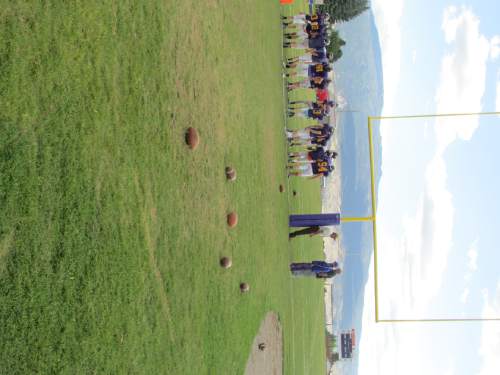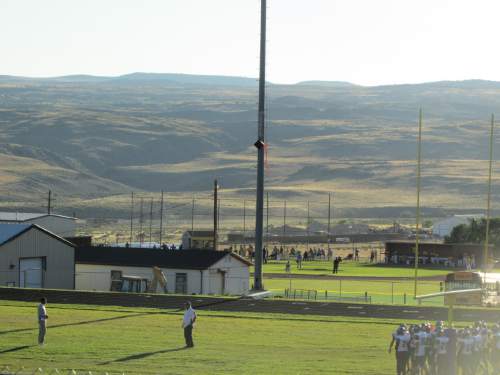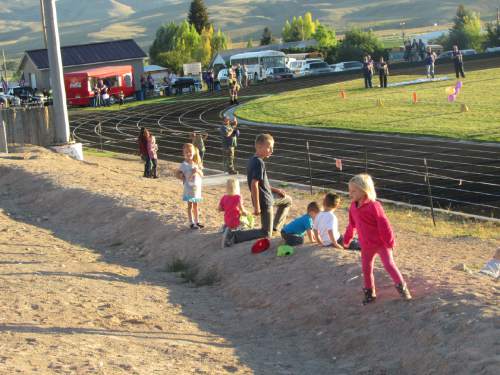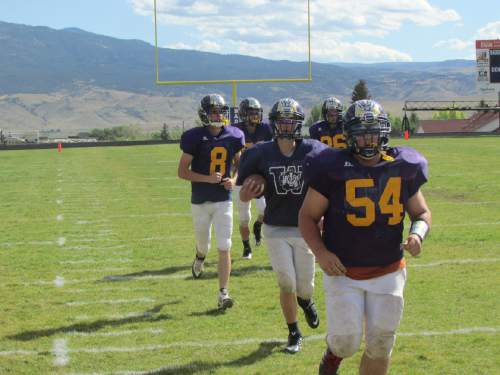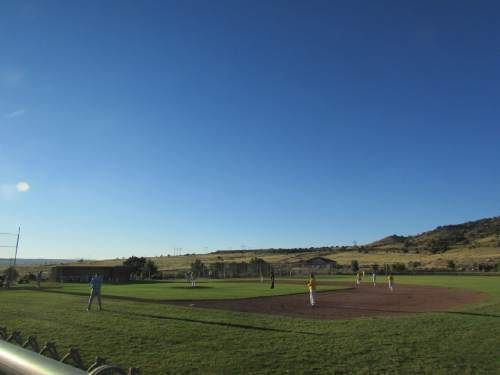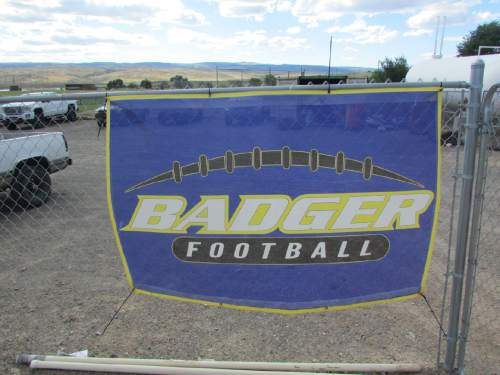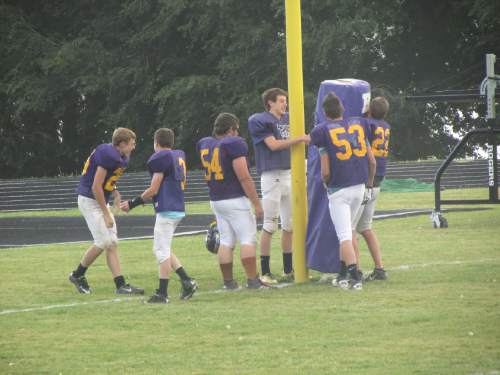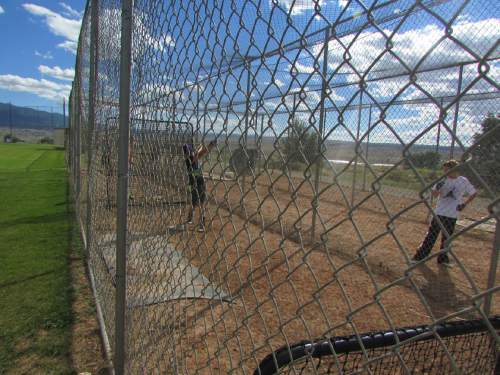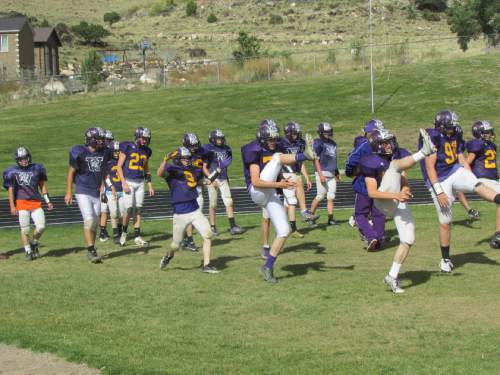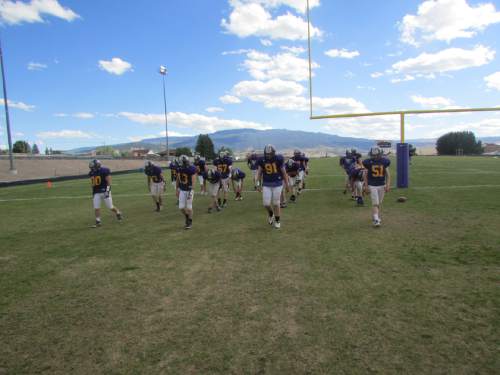This is an archived article that was published on sltrib.com in 2015, and information in the article may be outdated. It is provided only for personal research purposes and may not be reprinted.
Bicknell • The moment seemed perfect.
Several hundred people from the small towns of Bicknell, Torrey and Loa were in the bleachers as young flag-bearers stood on the grass of the high school football stadium.
The Parker and Boulder Mountains provided a scenic backdrop as fans stood for the national anthem played on a violin by a student. It was homecoming at Wayne High School. Friday night lights beamed down.
This event featuring girls with long dresses, boys trying to win a football game, and adoring parents watching with pride might seem normal. After all, the scene is repeated at a hundred or so schools throughout the state this time of year.
But this was different. This was the first varsity football homecoming ever held in the school's 101-year-old history.
A community's effort
The purple-clad team on the field needed hundreds of dollars of community support and hours of volunteer effort by coach Rick McCartney and his staff of five assistants to reach a point where the Badgers could play football. Wayne, a Class 1A school with 157 students, has never had a varsity football team until this year. It is primarily known for its baseball team, which also competes in the fall. Football is new.
McCartney, a retired Marine who played linebacker for West Virginia, moved to Wayne County with his wife, a native of the area, in 2008. Six years ago, he started a junior high football team.
It wasn't long before parents began wanting a high school squad. But in a rural area strapped for cash, and with an established baseball program, proposing tax dollars to fund football was not well-received.
"We had a number of citizen groups who were interested in football," said Wayne County superintendent Burke Torgerson. "It started as an after-school program in junior high. They wanted to move into the high school. They came to the school board to support the program. It was not feasible for the school to do it."
Undeterred, McCartney and the football supporters came up with another plan.
If they could rally community support to pay all costs associated with football — including uniforms, transportation to road games, scoreboards, goalposts, lights, electricity, even cleaning the locker room after the game — would the board allow the school to be part of the Utah High School Activities Association and play varsity football?
The answer was a contract with the Badger Boosters from a skeptical and reluctant board. Unlike other school sports, the team would have to be completely self-funded.
McCartney went to work. Getting help, equipment and advice from other small-town schools such as North and South Summit, Kanab and Manti, he started to build a varsity team from scratch. Class 1A football is struggling so much in Utah, with so few small schools playing, that schools such as Milford agreed to come to Bicknell to help the Badgers save travel costs.
A friend in Montana told McCartney about a junior college in Texas that had replaced its light standards and had four available. So Edwards Trucking from Wayne County sent a truck to Texas to pick them up. Garkane Energy put them up.
Dads built the goalposts from donated materials from Loa Builders Supply. South Central Communications donated a public address system, and the booster club put together a concession stand. Sponsors paid for a scoreboard. Bleachers were borrowed from the County Fairgrounds and will be returned after the season.
"This needed to come together for us to have football," said McCartney. "We agreed and we are not whining about it. Everybody wants to help us. We haven't gotten much financial help out of the area, nor have we sought it. This community takes care of itself."
A community's concerns
The Badgers played junior varsity ball a year ago, winning one game. They are struggling this season while still learning a new game.
Friends convinced Brogan Reynolds, a senior right guard and defensive end, to try the sport.
"I watch a lot of sports on television and I know the basic rules," he said about football. "But the plays, the responsibilities for different positions and even the footwork was new to me. I have had fun at practice sometimes and the games are fun. It's pretty cool to say I played in the first varsity game."
Yet, there are skeptics and concerns about football coming to Wayne High School.
"It was a change," said athletic director Heidi Woolsey, who loves watching football. "We have a super baseball program. The initial thought was that this was going to interrupt our great baseball program by taking kids from baseball to football and splitting our athletes up."
This would not be a problem in a bigger, urban school. But Wayne has approximately 75 boys in its upper four grades. Eighteen are on the fall baseball team, 28 on the football team and two are running cross-country.
Scott Ellett, the Wayne baseball coach since 2001, brother of high school principal Mary Bray and a middle school science teacher, said a few baseball players have decided to play football. He starts teaching baseball to kids in elementary school and, as a middle school teacher, knows which athletes are in the pipeline.
"We have 109 students [in the middle school]," he said while sitting in the dugout of the baseball team not far below where football practice was taking place. "You split that in half and you have 50 boys. Out of 50, you cut the number in half for the ones that play sports. Those are the ones that carry the program. When you have the best athletes in small numbers, you have to split those between two sports."
Some suggested that Wayne, which has won five 1A baseball state titles since Ellett took over, move that program to 2A and play in the spring (1A is the only classification in the state to play baseball in autumn rather than spring). But the coach said that would be difficult because Bicknell sits at about 7,000 feet, making spring baseball a cold and wet proposition that would be difficult to pull off.
Baseball player Brendin Robins said adding football has not been too hard on the baseball team.
"We had a couple of players who had been playing baseball now playing football," he said. "It may have more of an effect in the future than it has now just because a lot of kids are starting to like football. I grew up playing baseball and enjoy it, but my little brother plays football."
Ellett also knows the value of extracurricular activities and the fact that kids in smaller schools often have more of a chance to participate. He has a son and a daughter who both graduated from Harvard, and says they were admitted in the first place thanks to being involved in so many school activities at Wayne High.
Bray, the school principal who is supportive of the football program, said that the first thing some employers ask when hiring is "'Did you play on a sports team?' Playing on a team with the skills and things you learn from that competition is important."
She said football gives some kids an opportunity to get that competition they might not otherwise have.
"Football isn't cheap," she said. "We have support and commitment from the community. I have been surprised and pleased."
A community's support
Homecoming at Wayne was different this year.
The sound of baseball fans and aluminum bats connecting with balls could be heard from the football field as the Badgers finished a 3 p.m. game with rival Piute before an appreciative crowd. Inside the gym, the girls' volleyball team played at 4 p.m. With cheerleaders, a small dance troupe and musicians, it seemed as if most of the county gathered at the school that afternoon.
Seeing several hundred fans and the lights shining down on a the field for a traditional homecoming had to be satisfying to McCartney, who downplays what must have been hundreds of hours of volunteer effort to get to this point.
"I was not looking to be busy," he said. "I am doing what I have been educated to do my entire life, which is to help kids and provide opportunity. I can't whine about problems if I don't choose to get involved. Our youth deserve so much nowadays. … We have to provide opportunities for them."
Asked about the homecoming game, a competitive contest the Badgers would eventually lose to Layton Christian, McCartney seemed quietly proud.
"This is a big week for the school," he said. "They haven't experienced a traditional homecoming before."
And so, on a recent Friday night, the several hundred county citizens gathered under lights that weren't available a few weeks ago to cheer on its football team. Some sat in cars at the edge of the field, many on the borrowed bleachers and even a few on ATVs they rode to the game.
"There is a lot of excitement in the community that this is happening," said Bicknell town council member Kerry Stevens, who is the public address announcer at football games. "There is something about turning on those lights that reflect on the red ledges and can be seen a long ways away that creates quite a buzz. Everybody is talking about it and wondering how it is going. … People come around the turn from Lyman, looking into Bicknell and seeing the cars around the football field and comment on how neat that is."
Utah's newest football program had finally arrived at one of its oldest high schools.
Twitter: @tribtomwharton —
About Wayne High football
• Wayne High School in Bicknell is playing varsity football this season for the first time in its 101-year history.
• With the local school board unable to finance the new program, the Badger Boosters club contractually agreed to self-fund the team.
• Among the efforts contributing to a program built from scratch: a local trucking company picked up lighting standards from a junior college in Texas and the local power company installed them; a building supply company donated the materials for goalposts, which were assembled by parents; a telecom company donated a public address system; bleachers are borrowed from the County Fairgrounds.
• Despite concerns about football conflicting with fall baseball, the former has 28 participants and the latter has 18.


